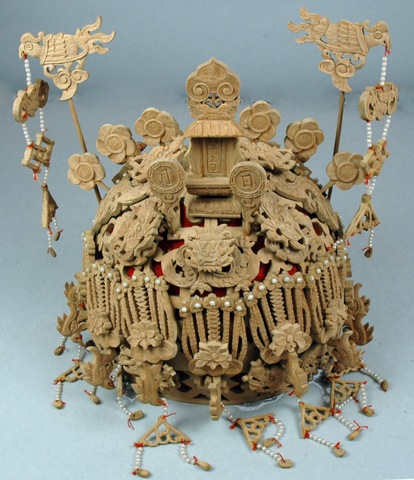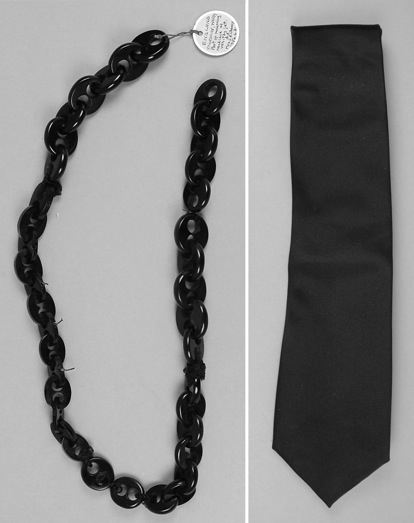Death
 Burial headdress from China
Burial headdress from China
Though death is often accompanied by powerful emotional responses we are also all influenced by culturally prescribed reactions to death. These differ around the world but most societies see death in terms of transition and part of that is the preparation of the body after death. This practice often relates to religious beliefs regarding the afterlife and the safe passage of the spirit to its new home. Sometimes, the concern is with freeing the spirit by removing superficial markings on the body; on the Marquesas Islands in French Polynesia, a person's tattoos have to be removed at death (either by rubbing them off or cutting away those areas of skin) in order for he or she to enter the realm of the gods. In Nigeria, funeral ceremonies include ritual pottery incised with scarification marks that match those on the body. At the end of the ceremony the pots are smashed to allow the ancestral spirit to move on. In many other cultures however, the journey to the afterlife is assisted by adding things to the body such as clothes, ornaments or paint.
Grave-goods including perfume, cosmetics and jewellery have been found in burials dating to the Palaeolithic period. The Ancient Egyptians saw death as just an interruption, rather than the end, of life. Unlike other cultures that prioritise the invisible self – the soul or spirit – over the body after death, in Egypt preservation of the physical body was just as vital for ensuring eternal life. The mummification technique was perfected by the New Kingdom 3500 years ago. The process took seventy days and involved removing the internal organs, desiccating the body with salt, then applying oils and perfume before wrapping it in linen with protective amulets and placing it in a decorated coffin.
For the aboriginal peoples of northern Australia, paint plays a major part in life's ritual ceremonies. The Yolngu, who live in Arnhem Land, believe that a person has two spirits, one positive and one negative. The purpose of their burial ceremonies is to guide the positive spirit back to its ancestral home in the clan's territory where it will remerge one day, whilst also driving the negative spirit away into the forest. To this end the body, or more commonly today, the coffin lid, is painted with specific designs. Together with incantations and dancing these designs summon the ancestral beings to identify the spirit and remove it from the body, bearing it back to its rightful clan home. The flesh beneath the painted skin is associated with the negative spirit so is dispersed in the ground through burial.
 Traditional mourning attire from Great BritainAfter a funeral, whether a burial or cremation, those who knew the deceased observe a period of mourning. Mourning is usually marked in a visual way, perhaps through the wearing of black or white (as in the white mourning dresses worn by medieval European queens), the application of grey 'mourning mud' as practised in parts of Melanesia, or the shaving or grooming of hair. Whilst death is commonly associated with the requirement for the mourners to dress in a sombre fashion, there are exceptions; the Tiwi of Melville Island off the northern coast of Australia hold extremely elaborate mortuary ceremonies in which the participants dress in their finest clothing, almost competing with each other to look the most colourful and splendid. In Tahiti, the bereaved family of a high-ranking man or woman would arrange for a group of mourners to grieve publicly. The chief mourner wore a spectacular and expensive costume of pearl shell, turtle shell, barkcloth and tropical bird feathers.
Traditional mourning attire from Great BritainAfter a funeral, whether a burial or cremation, those who knew the deceased observe a period of mourning. Mourning is usually marked in a visual way, perhaps through the wearing of black or white (as in the white mourning dresses worn by medieval European queens), the application of grey 'mourning mud' as practised in parts of Melanesia, or the shaving or grooming of hair. Whilst death is commonly associated with the requirement for the mourners to dress in a sombre fashion, there are exceptions; the Tiwi of Melville Island off the northern coast of Australia hold extremely elaborate mortuary ceremonies in which the participants dress in their finest clothing, almost competing with each other to look the most colourful and splendid. In Tahiti, the bereaved family of a high-ranking man or woman would arrange for a group of mourners to grieve publicly. The chief mourner wore a spectacular and expensive costume of pearl shell, turtle shell, barkcloth and tropical bird feathers.
In contrast, other societies demand a restrictive or punitive treatment of mourners' bodies. Tisha B'Av is an official day of mourning for Jews, commemorating the destruction of the Temple in Jerusalem in ancient times. On this day observant Jews refrain from bathing, wearing make-up or leather shoes. Many miles away in Tonga, a 19th-century visitor recalled how he saw men at the funeral of a chief inflict abuse upon themselves in a show of despair, drawing blood by beating and cutting themselves with shells.
Mourners are often recognisable by their style of dress. In Roman times, widows wore a ricinium, a distinctive shawl-like garment incorporating a cowl or hood that was made of dark red wool, red being associated with blood and death. She wore the ricinium for the prescribed year of mourning but possibly afterwards too.
Today it is thought appropriate to wear black at a funeral. It is commonly believed that Queen Victoria popularized the wearing of mourning black after she was only seen in public in that colour following the death of her husband, Prince Albert. However, the association of black with death had been established long before this. Royalty and aristocracy in England adopted black mourning dress in 14th century. By the 17th century the custom had spread down to the blossoming bourgeois classes. During the prescribed period of 'first mourning' only black, non-reflective fabrics could be worn but after some time had passed and the bereaved entered 'half mourning', they could move on to sombre colours such as grey or mauve. The wearing of a black mourning cap and veil may have had its origins in the convent. The nun's black habit did not start as a symbol of religion but rather as the widow's dress of the time. For nuns such as the Sisters of St Joseph in France, founded in the 17th century, they found that adopting the widow's attire of a black serge cloak and veil hid their femininity and sexuality – which were no longer important to hem or society – and gave them greater freedom and independence when out attending the poor and sick in the community.Whilst it is common to find people wearing black just for the funeral ceremony itself, widows in rural areas of Catholic Europe, Greece and Mexico will wear black for the rest of their lives.
Whilst it is common to find people wearing black just for the funeral ceremony itself, widows in rural areas of Catholic Europe, Greece and Mexico will wear black for the rest of their lives. Mourning jewellery incorporating the hair, likeness or name of the deceased, and commemorative tattoos are other longer-term ways of connecting the body to remembrance.
